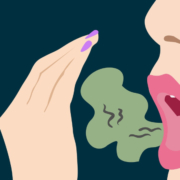Recently, I saw this meme on twitter that said, “now people with bad breath can suffer the way they make others suffer”. The attached photo was of a man wearing a mask. Bad breath is unpleasant, inconveniencing, and disrespectful. Okay I am done with the seemingly deprecating words considering we are going to talk about bad breath or halitosis and why it is caused by a myriad of factors and not just neglect of brushing one’s teeth.
What is Halitosis?
Halitosis is the persistent and unpleasant odor that comes out of a person’s mouth on exhalation. Considering its many causes, it is classified to ease the taxonomy. The major groups are real halitosis and psychogenic halitosis. Real halitosis is one where the malodor can be objectively verified and measured while psychogenic halitosis is subjective to the patient and can only be detected by them.
Real halitosis is further divided into intraoral and extra oral halitosis. Our lens in this blog today will be on the intra oral one considering the dental specialty which is our niche. Another form of halitosis is transient halitosis which is temporary and is directly related to what someone has ingested. it lasts a few minutes to hours and is not pathologic.
How does intraoral halitosis come about?
The pathophysiology of intraoral halitosis; in the mouth, an infection by gram negative anaerobic bacteria may happen. They usually invade the crypts and furrows on the posterior dorsal surface of the tongue. These microorganisms degrade organic substances like food debris, epithelial cells and saliva. The products from this degradation include volatile sulfur containing compounds and these are responsible for the bad smell. The bacteria are also associated with gum disease and thus gum disease can also be a cause of halitosis.
Causes of bad breath (halitosis)
These are some of the causes of halitosis.
- Gingivitis and periodontitis
- Inadequate restorations which have sites which trap food.
- Open carious lesions
- Decreased salivary flow which prevents the washing away of debris from the teeth and the tongue.
- Some local infections for example pericoronitis, periimplantitis and oral candidiasis.
- Oral dentures which are not well taken care of in conjunction with poor oral hygiene.
There are cofactors whose presence facilitates the development of halitosis. For example, stress, smoking, mouth breathing, unbalanced diet, decrease in water intake, excessive ingestion of coffee and alcohol. These in their own way each play a role in the pathophysiology and can exacerbate the development of halitosis.
When do I need to see a dentist?
Bad breath, especially if one religiously brushes their teeth and it insists on wafting from their mouth is psychologically and socially distressing. Such a person does well to see a dentist because the other efforts such as; chewing gum, candies, mouth rinse only offer a temporary masking effect.
The dentist will examine and establish a cause and thus design an effective treatment plan. When the cause is treated, the effect is more long lasting or even permanent which is desirable. Treatment is majorly on the patient’s hands. This is because they need to modify how they brush their teeth to include brushing the posterior dorsal surface of the tongue. There are special tongue brushes which effectively remove the coating that is home to the pathogenic bacteria.
A modification in diet to include more zinc and vitamins is also needed. A mouth wash which contains a flavor e.g. mint (masks the smell), a bactericidal agent e.g. chlorhexidine and a neutralizing component e.g. zinc also helps in the treatment. In case there are conditions in the mouth for example gingivitis or carious lesions, these must also be attended to effectively treat the halitosis.

